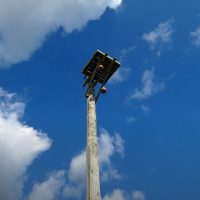“Gourds Go Up” by Connie Sidles

On Tuesday, March 23rd, Arborist Shea Cope found himself swaying 30 feet high on the Osprey nest pole near the Loop Trail at Union Bay Natural Area. He had climbed to the top of the pole using first a ladder and then tree-climbing spurs. Now he called down to his arborist colleague, Clif Edwards, “Send up the gourds.”
Attaching two specially-prepared gourds to a system of wires and pulleys, Clif sent them flying up.
Read moreViburnum: A Starring Role in Science

The next time you treat yourself to a walk through the inviting grounds of UW Botanic Gardens, take a moment to appreciate that the flowers and trees play an important role in scientific research–with implications for plants and research institutions all over the world.
“We get requests for plant materials from researchers and institutions about 10 times a year,” reports Raymond J.
“Magnificent Magnolias!”

If you missed our peak magnolia bloom, you can extend their beauty virtually here enjoying several wonderful photos of a few of my personal favorites. Many thanks to both Niall Dunne – Arboretum Foundation Communications Manager and Bulletin editor, Ray Larson – UW Botanic Gardens Interim Director and Skylar Lin – PSGO aerial photographer for sharing their extraordinary photos capturing these magnificent magnolias in bloom!
Read moreUnraveling the Mysteries of Seeds

Sometimes it takes a while to unravel the mystery of seeds; other times they present no mystery at all. Take showy stickseed (Hackelia venusta) seeds as an example of the former. The germination ecology of showy stickseed was for years a mystery. Traditional propagation techniques using cold stratification yielded poor germination rates. Researchers experimented with various scarification techniques (altering the seed coat by weakening or creating an opening) and gibberellic acid, a plant growth hormone, to stimulate germination.
Read moreConserving plants by investing in people

It’s an early winter morning at the Center for Urban Horticulture greenhouse. While the sun considers rising, Sarah Shank greets her seedlings. Fueled by a passion for growing plants and her first cup of coffee, she describes her quiet mornings watering rare native plants as the perfect way to begin her workday. The current plants she tends to, Astragalus sinuatus (Whited’s milk-vetch) and Eriogonum codium (Umtanum buckwheat), she grew from seed and each day begins with observing them.
Read more“Firs Things Firs”

1) Abies bornmuelleriana Turkish Fir
This species is allied to the Caucasian Fir (A. Nordmanniana), but with some characteristics of the Greek Fir (A. cephalonica), notably the resinous buds and glabrous shoots.
It has a small range in northwestern Asia Minor, where it forms forests on the Bithynian Olympus.
With regards to our collections at the Arboretum, we have a few specimens in the Northwest Pinetum, as well as the one shown here residing below the Pacific Connections New Zealand Garden.
Coppicing: The Endless Gift of Trees

A millennia-old arboricultural practice is alive and well at the SER-UW Native Plant Nursery: Coppicing.
Humans have coppiced trees for 10,000 years, estimates esteemed arborist and author William Logan Bryant. His recent book, Sprout Lands: Tending the Endless Gift of Trees, details this traditional practice with passion and reverence.
In the pre-Industrial era all over the globe, coppicing was the cutting back of a tree or shrub close to ground level in order to obtain a crucial, life-giving harvest: stems, canes and branches to be used for firewood, to build fences, furniture and bridges, and to produce baskets and rope, among many other essentials.
Signs of Spring at the Washington Park Arboretum

1) Leucothoe davisiae Sierra Laurel
This evergreen member of the Heath family is native to the mountains of eastern and northern California where it grows in bogs and seeps.
The hot-pink buds will open in spring to reveal white urn-shaped flowers.
You can find Leucothoe davisiae in the Cascadia Forest.
2) Magnolia sargentiana var.
Examples of the Plant Collections Network at the Washington Park Arboretum

Several genera at the Washington Park Arboretum are part of a multi-site nationally-accredited plant collection administered through the Plant Collections Network of the American Public Gardens Association. The Plant Collections Network is one of the most significant networks of cultivated living plant collections on Earth and is used for taxonomic studies, evaluation, breeding, and other research. The Network stewards diverse living collections at public gardens across North America to safeguard plants and share them with the world.
Read moreNew Year, New Tree: Winter Plant Sale at the SER-UW Nursery

Whether you’re aiming to beautify your yard or hoping to decrease your soil erosion rate, planting a tree would offer benefits beyond your intention. Trees are the foundation of maintaining a sustainable wellbeing. When you plant a tree, you are providing a new source of oxygen, introducing an efficient way to rid the air and soil of pollutants, and contributing to habitat in tree canopies for wildlife.
Read more